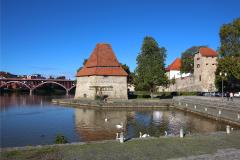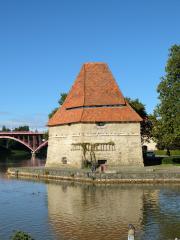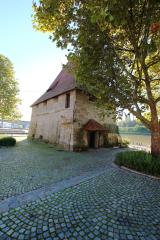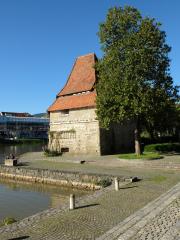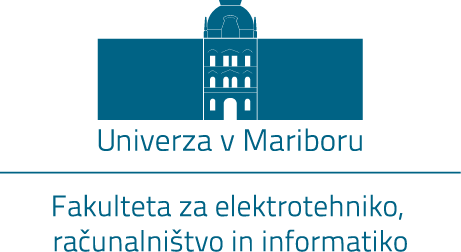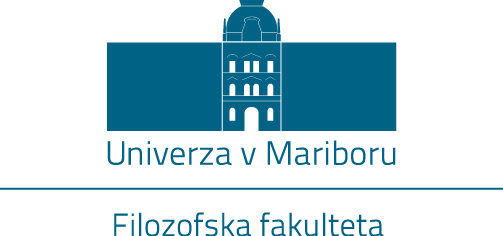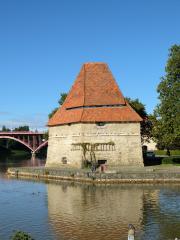
The Water Tower
Location: left riverbank of the Drava River, on the edge of Lent (Usnjarska 10)
Architects: Domenico dell'Allio (Lalio, Layo, Lago), Andrea dell'Allio, Valentin Treveno, Pietro Antonio de Pigrato
Time of construction: 1555
The so-called Water Tower is a Late Renaissance fort on the southeast section of the town wall on the left riverbank of the Drava River.
The construction of the town wall began right after Maribor obtained its town privileges. The wall, which is shaped like a rhomb with approximately 500 m long sides, was built between 1255 and 1275. It covered around 25 hectares and delineated the space between the Drava River and today's Strossmayerjeva ulica, Gregorčičeva ulica and Ulica škofa Maksimilijana Držečnika streets. The Minorite monastery, which leans against the town wall, and the Jewish quarter with the Synagogue were built at the same time. Žički dvor (Žiče Court) was also built next to the southern town wall.
The construction of the wall changed the town's urban design and stopped city traffic, especially the connection between the wooden bridge and Koroška cesta. Consequently, Dravska ulica was built in the southeastern part of Glavni trg (Main Square), as well as other new streets in the eastern part of town. The construction of the wall prompted a new traffic regulation, which developed an important connection between three town gates (Koroška or Gospejina vrata, Graška or Ulrikova vrata and Dravska or Vodna vrata) with an intersection on Glavni trg. As a result, the density of the population was uneven; the northwestern part of the town remained underpopulated until the beginning of the 20th century.
The initial town wall did not have defence towers. The angular towers on the south- and northwestern corner and above the four town gates (Dravska, Pristaniška, Koroška and Graška vrata) were not built until the beginning of the 14th century. The angular tower next to the town's parish church, today's bell tower of the Maribor Cathedral, represented the core of the town.
When the town wall was reconstructed between 1460 and 1470, several new defence towers were built. They were located mostly in the north and southeast. Today, the Jewish Tower and Čeligi Tower are preserved.
After 1523, when Turkish invasions reoccurred and new types of firearms appeared, it was necessary to establish a new defence system in Maribor. At the beginning of the 16th century, the citizens made several small repairs; however, Italian construction workers under the leadership of the brothers Domenico and Andrea dell'Allio, Valentino Treveno and Pietro Antonio de Pigrata completed the main renovations between 1550 and 1562. The regional government covered the better part of the costs. Based on the most modern principles of military architecture and the plans by the chief supervisor of military architecture of Inner Austria, Domenico dell'Allio, the town walls of other towns in Inner Austria, including Graz, Ptuj, Bad Radkersburg, Brežice, Klagenfurt and Varaždin, were renovated as well.
Four new bastions, which protected Koroška vrata, the entrances to the town port and the town's northeastern corner next to the castle, were built as part of the complete renovation of the town wall.
Besides the castle's bastion, the Water Tower is the only preserved part on the eastern side of the former southern line of defence. It was built in 1555 in place of the former round Smodniški Tower, attested in the archives in 1529. The Water Tower has a regular pentagonal ground plan and is built as a defence fort made of massive bricks with a high hip roof and a simple façade. The latter is divided by slits and a semi-circular cornice. Two sets of doors lead into the building, which faces the riverbed and is shaped like a wedge. Through building the new part of the town wall, the Italian builders connected the Water Tower with the older Jewish Tower.
In the second half of the 1960s, when the hydroelectric power plant was built, the fate of the tower was uncertain. Since the damming of the Drava River, the tower, together with the other water fort, the so-called Benetke (Venice), were planned to be demolished. While Benetke was destroyed, local authorities wanted to preserve the Water Tower. Consequently, in 1967, they gave the project of preserving this important part of the Renaissance town wall to civil engineer Jože Požauko, who managed to erect 1500 tons of architecture at its present location. They also demolished the cap brick vaults on the ground floor of the tower, which were reconstructed in the middle of the 1980s. The tower's exterior was also restored then.
Because of its preserved monumental fort architecture and its location on the riverside, the Water Tower is one of the most important architectural symbols of Maribor. There is a wine shop in the tower, which offers visitors a wide selection of Slovenian wines.
Tina Košak
(25 September 2014)
